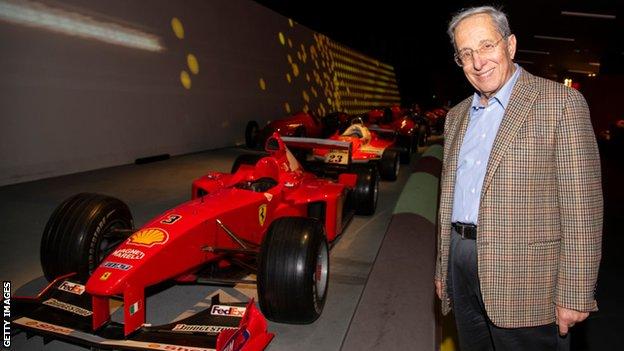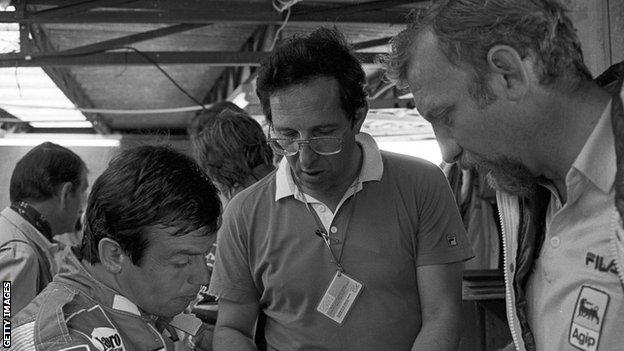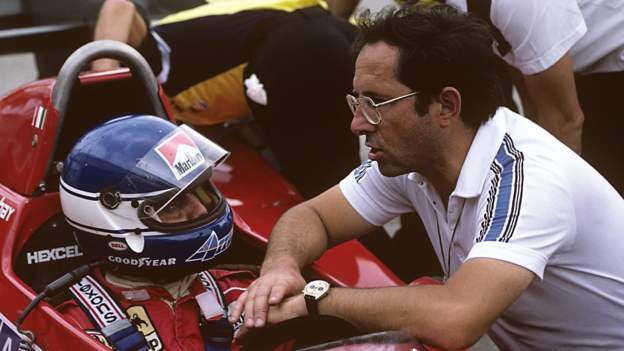
Legendary Ferrari designer Mauro Forghieri has died at the age of 87.
The Italian was an iconic figure who oversaw four Formula 1 drivers’ championships and seven constructors’ titles in his 27 years with the team.
Forghieri was a true engineering all-rounder, creating innovations in chassis, engine and gearbox design.
He designed some of Ferrari’s most famous cars, including the 312 T series that won three drivers’ and four constructors’ titles from 1975-79.
Forghieri was the first engineer to put aerodynamic rear wings on a car, at the 1968 Belgian Grand Prix, helping Ferrari driver Chris Amon to pole position, nearly four seconds faster than the next quickest car.
And he designed Ferrari’s first turbocharged engine. Introduced in 1981, four years after Renault pioneered the technology in F1, Ferrari became the first team to win the constructors’ title with a turbo car in 1982, and repeated the feat in 1983.
‘He was something special’
Mattia Binotto, Scuderia Ferrari team principal and managing director, paid tribute to Forghieri.
He said: “Today is a very sad day for everyone at Scuderia Ferrari.
“We mourn the passing of Mauro Forghieri, one of the most amazing people to have worked here.
“With his brilliant insights, he was one of the last all-round engineers in the car world. I met him on various occasions and each time was something special.
“He was, to the end, a truly charismatic individual. His revolutionary ideas, together with his vibrant nature, his abilities as a great motivator, meant he played a very important role in some of the most significant moments of Ferrari’s history and he did more than most to fuel the Prancing Horse legend. We will all miss him.”
Formula 1 president Stefano Domenicali said: “I am very saddened to hear the news that our friend Mauro Forghieri has passed away. He was a huge part of F1 and Ferrari and leaves behind an incredible legacy for all of us. My thoughts and prayers are with his family and friends at this sad time.”
Forghieri joined Ferrari in 1960, and within a year was in charge of the design programme at the age of 27, after key figures left the team in 1961 in what was known as ‘the great walk-out’, leaving him as the only engineer remaining on staff.
He was soon appointed technical director of Scuderia Ferrari, a position he retained until 1984.
He took over and completed the design of the 250 GTO GT car, an example of which has since become the most expensive car in the world at auction.

Forghieri’s first F1 victory as a designer came at the 1963 German Grand Prix, and a year later Ferrari won a drivers’ and constructors’ title double, with Briton John Surtees prevailing in a close contest with fellow countrymen Jim Clark and Graham Hill.
Ferrari’s fortunes waned in F1 in the late 1960s as the Ford Cosworth engine came to the fore. But Forghieri’s designs continued to have success in sports-car racing, including with the elegant 330 P4 that engaged in battles with the Ford GT40 that have gone down in racing folklore, and which recently featured in the Hollywood movie Ford v Ferrari.
Success in F1 began to return in the early 1970s, as Forghieri’s 312 B designs took occasional victories, before a winless 1973 led to the reconstitution of the team under Luca di Montezemolo’s leadership.
Ferrari returned to the victory’ circle in 1974, before Niki Lauda swept all before him in 1975 in Forghieri’s transverse-gearbox, flat 12-engined 312 T design.
Lauda would have won the title again in the 312 T2 in 1976, only to suffer a fiery crash at the German Grand Prix that left him with severe burns. In one of the most courageous acts in sporting history, the Austrian was back behind the wheel 42 days later at the Italian Grand Prix in an attempt to fend off the charge of the Englishman James Hunt in the McLaren.
Lauda eventually lost out to Hunt after pulling into the pits and refusing to continue in torrential conditions at the Japanese Grand Prix.
Another constructors’ title was Ferrari’s consolation, and Lauda returned to win a second drivers’ crown in 1977, before leaving the team with three races still to go after falling out with Enzo Ferrari.
A third Ferrari drivers’ championship in five years followed in 1979, when South African Jody Scheckter led Canadian team-mate Gilles Villeneuve to a one-two in the 312 T4.
The advent of ground-effect aerodynamics saw off Forghieri’s famous and evocative flat-12 engine because its low, wide design obstructed the under-car venturi tunnels crucial for maximum cornering performance, and it was replaced by a turbo for 1981.
After a difficult first year with an uncompetitive chassis, Ferrari should have won another title double with 1982’s best car, the 126C2, but for accidents that befell both their drivers.
Villeneuve was killed in a horrendous cartwheel crash in qualifying for the Belgian Grand Prix.
His team-mate Didier Pironi was beginning to take control of the championship when he suffered a remarkably similar somersault accident in the pouring rain in practice in Germany two months later. The Frenchman survived, but his legs were badly injured, and he never raced in F1 again.
Despite missing the final five races of the season, Pironi lost out on the title by only five points but Ferrari prevailed in the constructors’ contest, repeating the feat in 1983.
Forghieri left his F1 position in 1984, moving over to work on a concept road design, Ferrari’s first four-wheel-drive car, the 408 4RM, his last task at Maranello.
He joined Lamborghini in 1987, and designed for them a V12 F1 engine that was used by the Larrousse-Lola team in 1989, and by Lotus in 1990.
Forghieri moved to the re-emerged Bugatti road car company in 1992, where he was involved in the development of the EB 110 and 112 road cars, before co-founding the Oral Engineering Group, a mechanical design company, with which he remained active until his death.


